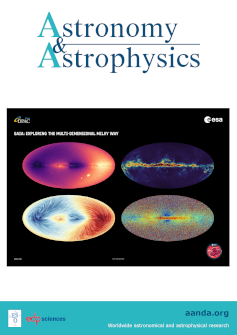Gravitational influence of the globular cluster NGC 7078 (M 15) flyby of the Oort cloud system
IF 5.4
2区 物理与天体物理
Q1 ASTRONOMY & ASTROPHYSICS
引用次数: 0
Abstract
Context. It is crucial to understand the interaction between globular clusters (GCs) and the Oort cloud, as close flybys of such massive objects can significantly disturb the cloud’s structure and redirect comets towards the inner Solar System. This increases the risk of impacts on Earth. Studying such events can teach us about the evolution and stability of the Solar System, as well as the effect of external gravitational forces on its dynamics over time.Aims. In our study of the gravitational effects of the flyby of the NGC 7078 or M 15 GC on the Oort cloud, we focus on two types of approximation. First, we investigate the impact on the Sun’s orbit during close passages, treating the GC as a point mass. At the second stage, we use a complete N-body system representation of the GC comprising over one million particles. The ultimate goal of the research is to quantify the number of particles stripped from the Oort cloud, and to understand the conditions under which this occurs.Methods. We carried out a dynamical study of the gravitational interaction between Oort cloud particles and galactic GCs within the time-varying galactic external potential. Initially, the GCs are represented as point masses orbiting the Galaxy alongside the Sun and the Oort cloud system. This study was also extended to include the case of NGC 7078, for which full N-body long-term dynamical modelling of the GC itself was used.Results. Our study reveals significant variations in the impact of NGC 7078 on the Oort cloud, depending on whether it is modelled as a point mass or a complete N-body system. The N-body system results in much greater stripping of Oort cloud particles, with over 52° stripped during a close pass, compared to a few percent in the point mass model for a flyby at a large distance (>200 pc) and 36° for a closer 10 pc point mass flyby. The N-body system also causes substantial expansion, with particles spreading over 50 pc from the Sun within 30 Myr after the GC’s crossing. This creates a twisted and flattened cloud structure with extended outer tails. These stripped cloud particles (more than 10°) spread across the galaxy, reaching distances of up to 16 kpc from the Sun. These differences emphasise the importance of using detailed N-body simulations to accurately evaluate the gravitational influence of GCs on the Oort cloud and shed light on the varying effects of simple versus complex system representations.球状星团NGC 7078 (m15)飞掠奥尔特云系统的引力影响
上下文。了解球状星团(GCs)和奥尔特云之间的相互作用是至关重要的,因为这种大质量物体的近距离飞行会显著扰乱奥尔特云的结构,并将彗星引向太阳系内部。这增加了撞击地球的风险。研究这些事件可以让我们了解太阳系的演化和稳定性,以及外部引力对其长期动力学的影响。在我们对NGC 7078或m15 GC飞掠对奥尔特云的引力效应的研究中,我们着重于两种近似。首先,我们研究了在近距离通过时对太阳轨道的影响,将GC视为一个点质量。在第二阶段,我们使用一个完整的n体系统表示的GC包含超过一百万个粒子。这项研究的最终目标是量化从奥尔特云中剥离的粒子的数量,并了解这种情况发生的条件。在随时间变化的星系外势下,我们对奥尔特云粒子与星系GCs之间的引力相互作用进行了动力学研究。最初,GCs被表示为围绕银河系、太阳和奥尔特云系统运行的点质量。该研究还扩展到ngc7078的情况,其中使用了GC本身的全n体长期动力学模型。我们的研究揭示了NGC 7078对奥尔特云的影响的显著变化,这取决于它是被建模为一个点质量还是一个完整的n体系统。n体系统导致奥尔特云粒子更大的剥离,在近距离飞掠期间剥离超过52°,相比之下,在大距离飞掠的点质量模型中剥离了几个百分点(约200个百分点),而在近10个百分点的点质量飞掠中剥离了36°。n体系统也导致了大量的膨胀,在GC穿越后的30迈内,粒子从太阳扩散到50%以上。这就形成了一个扭曲和扁平的云结构,并有延伸的外尾。这些被剥离的云粒子(超过10°)遍布整个星系,距离太阳最远可达16kpc。这些差异强调了使用详细的n体模拟来准确评估GCs对奥尔特云的引力影响的重要性,并揭示了简单与复杂系统表示的不同效果。
本文章由计算机程序翻译,如有差异,请以英文原文为准。
求助全文
约1分钟内获得全文
求助全文
来源期刊

Astronomy & Astrophysics
地学天文-天文与天体物理
CiteScore
10.20
自引率
27.70%
发文量
2105
审稿时长
1-2 weeks
期刊介绍:
Astronomy & Astrophysics is an international Journal that publishes papers on all aspects of astronomy and astrophysics (theoretical, observational, and instrumental) independently of the techniques used to obtain the results.
 求助内容:
求助内容: 应助结果提醒方式:
应助结果提醒方式:


